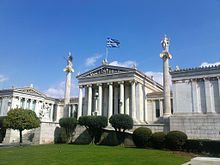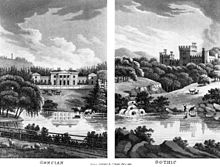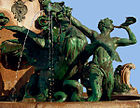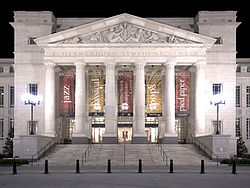- Neoclassicism
-
For other uses, see Neoclassical (disambiguation).
 Porcelain vase of "Medici Vase" profile, decorated in "Pompeian" black and red, St. Petersburg, ca. 1830
Porcelain vase of "Medici Vase" profile, decorated in "Pompeian" black and red, St. Petersburg, ca. 1830
Neoclassicism is the name given to Western movements in the decorative and visual arts, literature, theatre, music, and architecture that draw inspiration from the "classical" art and culture of Ancient Greece or Ancient Rome. One such movement was dominant in Europe from the mid-18th to the 19th centuries.
18th-century Neoclassical art responded to the perceived excesses of the contemporary Rococo style with a greater restraint in composition and severity of line.[1] Neoclassical architecture, emulated both classical and Renaissance structures, emphasizing order and simplicity. The subject-matter of Neoclassical art and literature was inspired by the emphasis on martial courage seen in the Greek and Latin epics.[2]
Contents
Overview
Neoclassicism presumes the existence of an agreed-upon "classical" canon of meritorious literary and artistic productions. Neoclassical artists, by virtue of a deep familiarity with the canon, attempt to resynthesize and extend the canon in each of their work. While avoiding mere reproduction of classical themes and motifs, the artist seeks to place his work in the context of a well-known tradition and demonstrate his mastery of the rules of the genre. In this respect, Neoclassicism is opposed to Modernism, in which self-expression and improvisation are considered virtues.
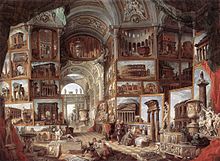 Late Baroque classicizing: G. P. Pannini assembles the canon of Roman ruins and Roman sculpture into one vast imaginary gallery (1756)
Late Baroque classicizing: G. P. Pannini assembles the canon of Roman ruins and Roman sculpture into one vast imaginary gallery (1756)
"Neoclassicism" in each art implies a particular canon of "classic" models - e.g. Virgil, Raphael, Nicolas Poussin, Haydn. Other cultures have other canons of classics, however, and a recurring strain of neoclassicism appears to be the natural expression of cultures that are confident of their mainstream traditions, but also feel the need to regain something that has slipped away. Apollonius of Rhodes was a neoclassic writer; Ming ceramics paid homage to Song-era celadon Chinese porcelains; Italian 15th century humanists learned to write a "Roman" hand we call italic (based on the Carolingian); Neo-Babylonian culture was a neoclassical revival[clarification needed], and in Persia Zoroastrianism was revived[when?] to re-Persianize a culture that had fallen away from its own classic Achaemenian past. Within the Western tradition, the earliest neoclassical art is the "Neo-Attic" Hellenistic and Roman sculptures produced from c. 100 BCE on. This category was identified by the German art historian Friedrich Hauser (Die Neuattische Reliefs Stuttgart 1889). Hauser's "Neo-Attic" consists of bas-reliefs molded on decorative vessels and plaques, employing a style of figure and drapery whose models were Athenian are of the late 5th and early 4th century BCE.
In architecture and in the decorative and visual arts
 Façade of the Larger Marble Palace (St. Petersburg, Russia) built by Luigi Vanvitelli's pupil Antonio Rinaldi.
Façade of the Larger Marble Palace (St. Petersburg, Russia) built by Luigi Vanvitelli's pupil Antonio Rinaldi.
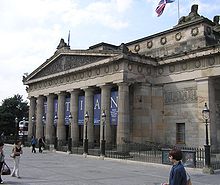 At the Royal Scottish Academy, Edinburgh, William Henry Playfair employs a Greek Doric octastyle portico.
At the Royal Scottish Academy, Edinburgh, William Henry Playfair employs a Greek Doric octastyle portico.
European Neoclassicism in the visual arts began c. 1765 in opposition to the then-dominant Baroque and Rococo styles. Rococo architecture emphasizes grace, ornamentation and asymmetry; Neoclassical architecture is based on the principles of simplicity and symmetry, which were seen as virtues of the arts of Rome and Ancient Greece, and were more immediately drawn frin 16th century Renaissance Classicism.
Contrasting with the Baroque and the Rococo, Neo-classical paintings are devoid of pastel colors and haziness; instead, they have sharp colors with Chiaroscuro. In the case of Neo-classicism in France, a prime example is Jacques Louis David whose paintings often use Roman and Greek elements to extol the French Revolution's virtues (state before family).
Each "neo"- classicism selects some models among the range of possible classics that are available to it, and ignores others. The neoclassical writers and talkers, patrons and collectors, artists and sculptors of 1765–1830 paid homage to an idea of the generation of Pheidias, but the sculpture examples they actually embraced were more likely to be Roman copies of Hellenistic sculptures. They ignored both Archaic Greek art and the works of Late Antiquity. The Rococo art of ancient Palmyra came as a revelation, through engravings in Wood's The Ruins of Palmyra. Even Greece was all-but-unvisited, a rough backwater of the Ottoman Empire, dangerous to explore, so neoclassicists' appreciation of Greek architecture was mediated through drawings and engravings, which subtly smoothed and regularized, "corrected' and "restored" the monuments of Greece, not always consciously. As for painting, Greek painting was utterly lost: neoclassicist painters imaginatively revived it, partly through bas-relief friezes, mosaics, and pottery painting and partly through the examples of painting and decoration of the High Renaissance of Raphael's generation, frescos in Nero's Domus Aurea, Pompeii and Herculaneum and through renewed admiration of Nicholas Poussin. Much "neoclassical" painting is more classicizing in subject matter than in anything else.
There is an anti-Rococo strain that can be detected in some European architecture of the earlier 18th century, most vividly represented in the Palladian architecture of Georgian Britain and Ireland, but also recognizable in a classicizing vein of architecture in Berlin. It is a robust architecture of self-restraint, academically selective now of "the best" Roman models.
Neoclassicism first gained influence in England and France, through a generation of French art students trained in Rome and influenced by the writings of Johann Joachim Winckelmann, and it was quickly adopted by progressive circles in Sweden. At first, classicizing decor was grafted onto familiar European forms, as in the interiors for Catherine II's lover Count Orlov, designed by an Italian architect with a team of Italian stuccadori: only the isolated oval medallions like cameos and the bas-relief overdoors hint of neoclassicism; the furnishings are fully Italian Rococo (illustration, left).
But a second neoclassic wave, more severe, more studied (through the medium of engravings) and more consciously archaeological, is associated with the height of the Napoleonic Empire. In France, the first phase of neoclassicism is expressed in the "Louis XVI style", the second phase in the styles we call "Directoire" or Empire. Italy clung to Rococo until the Napoleonic regimes brought the new archaeological classicism, which was embraced as a political statement by young, progressive, urban Italians with republican leanings.
Painting and the decorative arts
The high tide of neoclassicism in painting is exemplified in early paintings by Jacques-Louis David (illustration, left) and Jean Auguste Dominique Ingres' entire career. David's Oath of the Horatii was painted in Rome and made a splash at the Paris Salon of 1785. Its central perspective is perpendicular to the picture plane, made more emphatic by the dim arcade behind, against which the heroic figures are disposed as in a frieze, with a hint of the artificial lighting and staging of opera, and the classical coloring of Nicholas Poussin. In sculpture, the most familiar representatives are the Italian Antonio Canova, the Englishman John Flaxman and the Dane Bertel Thorvaldsen. The European neoclassical manner also took hold in the United States, where its prominence peaked somewhat later and is exemplified in the sculptures of William Henry Rinehart (1825–1874).
In the decorative arts, neoclassicism is exemplified in Empire furniture made in Paris, London, New York, Berlin; in Biedermeier furniture made in Austria; in Karl Friedrich Schinkel's museums in Berlin, Sir John Soane's Bank of England in London and the newly built "capitol" in Washington, DC; and in Wedgwood's bas reliefs and "black basaltes" vases. The Scots architect Charles Cameron created palatial Italianate interiors for the German-born Catherine II the Great in Russian St. Petersburg: the style was international.
Indoors, neoclassicism made a discovery of the genuine classic interior, inspired by the rediscoveries at Pompeii and Herculaneum, which had started in the late 1740s, but only achieved a wide audience in the 1760s, with the first luxurious volumes of tightly controlled distribution of Le Antichità di Ercolano. The antiquities of Herculaneum showed that even the most classicizing interiors of the Baroque, or the most "Roman" rooms of William Kent were based on basilica and temple exterior architecture, turned outside in: pedimented window frames turned into gilded mirrors, fireplaces topped with temple fronts, now all looking quite bombastic and absurd. The new interiors sought to recreate an authentically Roman and genuinely interior vocabulary, employing flatter, lighter motifs, sculpted in low frieze-like relief or painted in monotones en camaïeu ("like cameos"), isolated medallions or vases or busts or bucrania or other motifs, suspended on swags of laurel or ribbon, with slender arabesques against backgrounds, perhaps, of "Pompeiian red" or pale tints, or stone colors. The style in France was initially a Parisian style, the Goût grec, not a court style. Only when the plump, young king acceded to the throne in 1774 did his fashion-loving Queen bring the "Louis XVI" style to court.
From about 1800 a fresh influx of Greek architectural examples, seen through the medium of etchings and engravings, gave a new impetus to neoclassicism that is called the Greek Revival.
Neoclassicism continued to be a major force in academic art through the 19th century and beyond—a constant antithesis to Romanticism or Gothic revivals— although from the late 19th century on it had often been considered anti-modern, or even reactionary, in influential critical circles. By the mid-19th century, several European cities—notably St Petersburg and Munich—were transformed into veritable museums of Neoclassical architecture.
Gothic revival architecture (often linked with the Romantic cultural movement), a style originating in the 18th century which grew in popularity throughout the 19th century, contrasted Neoclassicism. Whilst Neoclassicism was characterized by Greek and Roman-influenced styles, geometric lines and order, Gothic revival architecture placed an emphasis on medieval-looking buildings, often made to have a rustic, "romantic", appearance. As a matter of fact, Romanticism grew as a response against Neoclassicism.[3]
Gallery
-
Henry Fuseli, The artist moved to despair at the grandeur of antique fragments, 1778–79
In American architecture, neoclassicism was one expression of the American Renaissance movement, ca 1890–1917; its last manifestation was in Beaux-Arts architecture, and its very last, large public projects were the Lincoln Memorial (highly criticized at the time), The National Gallery in Washington, DC (also heavily criticized by the architectural community as being backward thinking and old fashioned in its design), and the American Museum of Natural History's Roosevelt Memorial. These were white elephants when they were built. In the British Raj, Sir Edwin Lutyens' monumental city planning for New Delhi marks the glorious sunset of neoclassicism. World War II was to shatter most longing for – and imitation of – mythical, heroic times.
Covert neoclassicism in Modern styles
Conservative modernist architects such as Charles Perret in France kept the rhythms and spacing of columnar architecture even in factory buildings. Where a colonnade would have been decried as "reactionary," a building's pilaster-like fluted panels under a repeating frieze looked "progressive." Pablo Picasso experimented with classicizing motifs in the years immediately following World War I, and the Art Deco style that peaked in the 1925 Paris Exposition des Arts Décoratifs often drew on neoclassical motifs without expressing them overtly: severe, blocky commodes by E. J. Ruhlmann or Sue et Mare; crisp, extremely low-relief friezes of damsels and gazelles in every medium; fashionable dresses that were draped or cut on the bias to recreate Grecian lines; the art dance of Isadora Duncan; the Streamline Moderne styling of US post offices and county court buildings built as late as 1950; and the Roosevelt dime.
In music
Although the practice of borrowing musical styles from the past has not been uncommon throughout musical history, art musics have gone through periods where musicians used modern techniques coupled with older forms or harmonies to create new kinds of works. In classical music, this was most notably practiced between the 1920s and the 1950s. Igor Stravinsky is the most well known composer ascribed to this style, who effectively began the musical revolution with his Bach-like Octet for Wind Instruments (1923). A particular individual work that represents this style well is Prokofiev's Classical Symphony.
Between the Wars
There was an entire 20th century movement in the Arts which was also called Neo-classicism. It encompassed at least music, philosophy, and literature. It was between the end of World War I and the end of World War II. For information on the musical aspects, see 20th century classical music and Neoclassicism (music). For information on the philosophical aspects, see Great Books.
This literary neo-classical movement rejected the extreme romanticism of (for example) dada, in favour of restraint, religion (specifically Christianity) and a reactionary political program. Although the foundations for this movement in English literature were laid by T. E. Hulme, the most famous neoclassicists were T. S. Eliot and Wyndham Lewis. In Russia, the movement crystallized as early as 1910 under the name of Acmeism, with Anna Akhmatova and Osip Mandelshtam as the leading representatives.
In Russia and the Soviet Union
In 1905–1914 Russian architecture passed through a brief but influential period of neoclassical revival; the trend began with recreation of Empire style of alexandrine period and quickly expanded into a variety of neo-Renaissance, palladian and modernized, yet recognizably classical schools. They were led by architects born in 1870s, who reached creative peak before World War I like Ivan Fomin, Vladimir Shchuko, Ivan Zholtovsky. When economy recovered in 1920s, these architects and their followers continued working in primarily modernist environment; some (Zholtovsky) strictly followed the classical canon, others (Fomin, Schuko, Ilya Golosov) developed their own modernized styles.[4]
With the crackdown on architects' independence and official denial of modernism (1932), demonstrated by the international contest for the Palace of Soviets, neoclassicism was instantly promoted as one of the choices in stalinist architecture, although not the only one. It coexisted with moderately modernist architecture of Boris Iofan, bordering with contemporary Art Deco (Schuko); again, the purest examples of the style were produced by Zholtovsky school that remained an isolated phenomena. The political intervention was a disaster for constructivist leaders yet was sincerely welcomed by architects of the classical schools.[5]
Neoclassicism was an easy choice for the USSR since it did not rely on modern construction technologies (steel frame or reinforced concrete) and could be reproduced in traditional masonry. Thus the designs of Zholtovsky, Fomin and other old masters were easily replicated in remote towns under strict material rationing. Improvement of construction technology after World War II permitted Stalinist architects to venture into skyscraper construction, although stylistically these skyscrapers (including "exported" architecture of Palace of Culture and Science, Warsaw and the Shanghai International Convention Centre) share little with the classical models. Neoclassicism and neo-Renaissance persisted in less demanding residential and office projects until 1955, when Nikita Khrushchev put an end to expensive Stalinist architecture.[5]
In the 21st century
After a lull during the period of modern architectural dominance (roughly post-WWII until the mid 1980s), neoclassicism has seen somewhat of a resurgence. In the United States some public buildings are built in the neoclassical style as of at least 2006, with the completion of the Schermerhorn Symphony Center.
In Britain a number of architects are active in the neoclassical style. Examples of their work include two university Libraries: Quinlan Terry's Maitland Robinson Library at Downing College and Robert Adam Architects' Sackler Library. The majority of new neoclassical buildings in Britain are private houses.[citation needed]
As of the first decade of the 21st century, neoclassical architecture is usually classed under the umbrella term of "traditional architecture".[6] Also, a number of pieces of postmodern architecture draw inspiration from and include explicit references to neoclassicism,[citation needed] the National Theatre of Catalonia in Barcelona among them. Postmodern architectural taste includes, in fact, historical elements, like column, capital or tympanum. Two of the most "classical" Postmodernism outgrowth are neo-eclectic architecture and neo-historicist architecture.
See also
- Adam style
- American Empire style
- Empire style
- Federal architecture
- Nazi architecture
- Neo-Grec, the late Greek-Revival style
- Neoclassical influenced fashions
- Stalinist architecture
References
- ^ Huntfor.com
- ^ Artsz.org
- ^ UH.edu
- ^ William C. Brumfield. The Origins of Modernism in Russian Architecture. University of California Press, 1991 online text
- ^ a b Dmitry Khnelnitsky. Stalin the Architect // Хмельницкий, Д., «Зодчий Сталин», М., «Новое литературное обозрение», 2007, ISBN 5-86793-496-9
- ^ Traditional Architecture Group
Further reading
See also the References at Neoclassical architecture
- Walter Friedlaender, 1952. David to Delacroix, (Originally published in German; reprinted 1980)
- Fritz Novotny, 1971. Painting and Sculpture in Europe, 1780-1880, 2nd edition. (reprinted 1980)
- Hugh Honour, 1968. Neo-classicism. Style and Civilisation 1968,(Reprinted 1977) .
- Robert Rosenblum, 1967. Transformations in Late Eighteenth Century Art
- David Irwin, 1966. English Neoclassical Art: Studies in Inspiration and Taste
- Svend Eriksen, Early Neoclassicism in France 1974.
- Gromort Georges (Author), Richard Sammons (Introductory Essay). The Elements of Classical Architecture (Classical America Series in Art and Architecture), 2001
External links
- Neoclassicism in the "History of Art"
- "Neoclassicism Style Guide". British Galleries. Victoria and Albert Museum. http://www.vam.ac.uk/vastatic/microsites/british_galleries/bg_styles/Style05a/index.html. Retrieved 2007-07-17.
- Neo-classical drawings in the Flemish Art Collection
- 19th Century Sculpture Derived From Greek Hellenistic Influence: Jacob Ungerer
- The Neoclassicising of Pompeii
Categories: -
Wikimedia Foundation. 2010.


